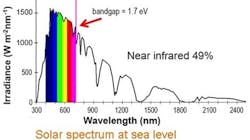IR light harvested and efficiently upconverted for photovoltaic, other uses
Groningen, The Netherlands--Scientists from the University of Groningen and the FOM Foundation (Utrecht, The Netherlands) have learned how to harvest IR light by transmitting its energy to an upconversion material. This energy is then available for use in photovoltaic cells or for medical imaging.
They use inorganic nanocrystals incorporating rare-earth metals, but attach organic "antenna" molecules to the nanocrystals. The antennae capture the IR photons, then the nanocrystal converts two IR captured photons to a single visible photon. The antennae molecules amplify this process 3300 times in comparison to nanocrystals without the antennae—a considerable improvement. The research was published on 15 July 2012 on the website of Nature Photonics.
"Even with our antennae, we still only capture a limited amount of the IR light," says University of Groningen professor Kees Hummelen, who leads the FOM-focus group 'Next generation organic photovoltaics'. "And even better yield can be obtained. Two photons must come together in the material within a short space of time. In practice, the efficiency of this process is still very low. However the harvest is already much better, so step one has been achieved." Therefore, the work of the researchers in Groningen is mainly a proof that IR photons can be harvested by means of upconversion.
Photovoltaic cells
The most obvious application is in solar cells, as about half of all the solar energy reaching the Earth's surface consists of IR light. "A German group is going to incorporate our nanocrystals with antennae in solar cells to test these in practice," says Hummelen, who since last year has led a FOM focus group researching the new generation of organic solar cells. By capturing more IR light, solar cells should be able to pass the so-called Shockley-Queisser efficiency limit (for single-junction solar cells, that limit is 32%).
The upconversion technique also has other applications, including medical imaging. "Infrared light penetrates further into biological tissues than visible light," says Hummelen. "If you allow compounds that carry out upconversion to bind to specific cells in tissues, then you can make images using IR light."
The research was largely carried out by FOM PhD student Wenqiang Zou, masters student Jeremio Maduro, and postdoc Cindy Visser and took place at the Stratingh Institute for Chemistry and the Zernike Institute for Advanced Materials (ZIAM), both part of the Faculty of Mathematics and Natural Sciences at the University of Groningen. Kees Hummelen and Maxim Pchenitchnikov supervised the work.

John Wallace | Senior Technical Editor (1998-2022)
John Wallace was with Laser Focus World for nearly 25 years, retiring in late June 2022. He obtained a bachelor's degree in mechanical engineering and physics at Rutgers University and a master's in optical engineering at the University of Rochester. Before becoming an editor, John worked as an engineer at RCA, Exxon, Eastman Kodak, and GCA Corporation.
